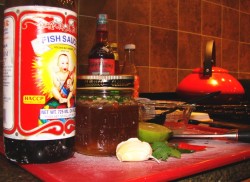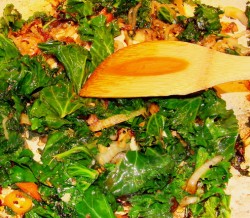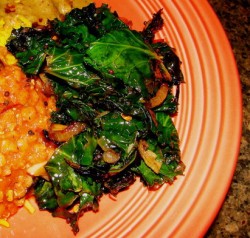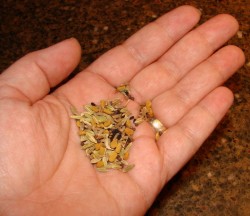What To Do With Nuoc Cham: Lemongrass Beef Over Broken Rice
Simple does not equate with plain.
You know, the phrase, “it’s plain and simple?”
Well, in cookery, those two words do not have to go together.
Food that comes together with a minimum of ingredients does not have to taste plain. Or bland. Or boring.
This recipe is a classic example of what I am trying to convey.
The stir fry, which is common in Saigon, is very easy to put together. It consists of tender beef, like sirloin, cut into thin strips, marinated in oyster sauce, fish sauce and fresh minced lemongrass, then stir fried quickly in a wok with some red onion and garlic.
That is it.
And that is all there needs to be, really. I mean, I make mine slightly differently, but it only really affects the color of the dish. The flavor, which is amazing, is still the same. It really is that simple. About ten minutes of prep, twenty minutes of marination and about six minutes of cooking time–give or take a minute or two depending on how fast you work with a knife and how hot your stove gets.
It is simple, yes, but oh, so delicious.
I do change mine up a bit. I add a bit of dark soy sauce to color the beef a more savory reddish-brown, and I use shallots instead of red onions, because I like the more delicate flavor a bit better in this stir fry. I also tend to have shallots in the pantry and not red onions, because I use them more often.
As for the presentation of the dish–it is most often served over cool, lightly cooked rice noodles–or “bun” in Vietnamese.
I love it that way, but I love the beef even better draped over a pile of freshly steamed, warm broken rice.
What is broken rice?
Broken rice is just what it sounds like: the rice grains that have not survived the milling process intact. In this case, it is jasmine rice that has gotten cracked and broken up into small bits which look like pearly, pure white couscous. When cooked the texture is also similar to couscous, but the familiar jasmine rice scent and flavor are retained. It is a thoroughly delightful use of a food product that could have gone to waste among less frugal people. I admire that.
It is also simple to cook. In the rice cooker, you just throw in equal proportions of rice and water. In other words, if you want to cook two cups of rice, you use two cups of water. That is that. You put it in the rice cooker, shut the lid down on it, push the button and walk away.
If you are cooking on the stove top, the proportion of broken rice to water is exactly the same. Put the rinsed rice into a pot with two cups of water. Bring to a boil, give it a nice stir, clap a tight lid down on it, turn the heat down to the lowest setting possible setting and cook for twenty minutes. Let it sit for five minutes off heat, then fluff with a fork. Done. Easy peasy.
The rest of the dish is just a matter of washing, cutting and preparing fresh vegetables.
Lettuces, herbs, carrots, cucumbers and bean sprouts are the classic salad ingredients that are presented in the bowl of noodles or rice with beef. I change it up a bit, and when I cannot get good bean sprouts, I leave them out. I add slivers of fresh snow peas instead, and when radishes are in season, as they are now, I cut them up into slivers and add them as well for a little icy bite. Fresh baby spinach is great in this, as is mizuna and shredded daikon or Japanese turnip. Suffice to say that I think that you could use any raw or lightly blanched vegetables that suits your fancy in this dish and all you would do is make it taste even better.
My favorite herbs, though, are cilantro, mint and Thai basil. The first two are necessary, and the third is necessary when it is in season, which around here means the summertime. But when it is in season, I use tons of it. Right now, I make up for not having it by using more cilantro.
What ties all of these disparate ingredients together into a cohesive whole which comprises cold, raw vegetables, herbs and greens with warm steamed broken rice and hot, straight out of the wok stir fried beef?
Nuoc cham. It is the glue of this dish, and without it, you might as well not even try to make it. So, if you are scared of fish sauce for whatever reason, don’t try to make this–it will taste really lame, you won’t like it and you will say, “Wow, why does Barbara go on about this dish so much. It is just, like boring and stuff.” Avoid that, and just make the nuoc cham, then make this dish, and then sit down with a big bowl of it and eat it.
Your soul will thank you. (And then thank me, too. Souls are that way. They are very grateful things.) This is serious Vietnamese soul food.
Your stomach will thank you, too. And if you feed it to your friends and family, they will thank you. There will be lots of thanking around this dish, trust me. It is just that amazing. It is an explosion of fresh and delightful flavors, all bursting in the mouth together. The meat is tender, savory and just unctuous with juice and goodness. The rice is fragrant with a slightly sticky texture that keeps you coming back for more. The greens and herbs are verdant and sharp. The vegetables are crisp, sweet and cool all at once. And the nuoc cham just swirls around the whole dish, bringing all the flavors into a friendly state of harmony.
You know, like a hostess at a party, who flits among her guests, breaking the ice, introducing people and getting the conversation started. That is the role nuoc cham plays here. It gets the party started in the bowl and continues it on in your mouth.
So, make this dish. Eat it, and love it, and come back for more.
I know I will.
Lemongrass Beef Over Broken Rice
Ingredients:
3 cups broken rice
3 cups water
8 cups loosely packed salad greens, washed, and dried, cut into bite sized pieces (I like baby greens, leaf lettuces, and romaine for this, but mizuna and baby spinach are also fantastic, as is baby chard)
2 cups loosely packed cilantro leaves, washed, dried and roughly chopped
1/2 cup loosely packed mint leaves, washed, dried and roughly chopped
1 cup loosely packed Thai basil leaves, washed, dried and roughly chopped (if you can get it)
4 cups julienned fresh vegetable garnish (I love carrots, seeded cucumber, sweet radishes, turnips, daikon, shredded snow pea and bean sprouts here)
1 full recipe nuoc cham
2/3 pound tender beef such as sirloin, partially frozen, and sliced across the grain into very thin slices about 1″X2″ in size
2 stalks lemongrass, bottom third of stalk only, tough outer leaves removed to expose tender inner core, then minced
2 tablespoons oyster sauce
1 tablespoon fish sauce
3 tablespoons canola or peanut oil
3 cloves garlic, peeled and minced
1 large shallot, peeled and thinly sliced
1 tablespoon dark soy sauce
Method:
Cook rice according to directions in post above.
While prepping the salad greens, herbs and vegetables, mix meat with the oyster sauce, fish sauce and lemongrass. Allow to marinate while prepping other ingredients, at least for twenty minutes.
Prepare salad greens, herbs and vegetables. Set out four large bowls. Divide salad greens among bowls, then divide the herbs. Sprinkle half of each portion of herbs on top of greens, hold off on the rest.
When the rice is cooked, divide it among the four bowls.
Divide the mixed julienned vegetables among the four bowls and sprinkle over and around the still steaming rice.
Divide the nuoc cham in half and drizzle that half over the vegetables and rice.
Heat wok until it smokes. Add oil, allow to heat for twenty to thirty seconds, then add garlic. Immediately add beef to wok, and spread into a single layer on the bottom. Leave undisturbed for a minute to brown. While beef is browning, layer shallot on top of it.
After you can smell the beef browning, vigorously stir fry the meat, garlic and shallots. When most of the pink is gone from the meat, drizzle in the dark soy sauce and mix thoroughly, in order to give the meat a delicious deep brown coloring.
Cook about thirty more seconds, then remove wok from heat. Immediately divide hot beef into four portions and put over the rice and vegetables, drizzling the beef juices and shallots as you go. Do not waste a drop of this lovely liquid!
Sprinkle with reserved herbs, and drizzle with the remaining half of nuoc cham.
Stir and eat!
Note: If you want, you can serve with some Thai sweet chili sauce for each diner to drizzle as they like over their own bowls. Or, you can make two batches of nuoc cham and allow them to add more as they like. Or, you can do like me and serve with both!
A Sauce of Golden Glory: Nuoc Cham
Vietnamese food, for all that I have seldom cooked it in the past, may become my newest culinary obsession.
Why?
Because the flavors are fresh, delicate and delightful.
Like Thai and Chinese foods, Vietnamese foods are an exercise in balance between flavors, colors, textures and aromas.
One of my favorite aspects of Vietnamese cookery is the prevalent use of and love for fresh herbs. The Vietnamese people are serious about their herbs and use them with a generous hand, eating them often as salads in and of themselves. The bright, intense flavors explode on the tongue, in a dazzling array of fragrance and texture. The use of strongly flavored fresh herbs enlivens Vietnamese foods, bringing a sparkle and brilliance to the plate that is hard to resist.
Another favorite aspect of Vietnamese cuisine for me is the use of table sauces and condiments, most of them freshly made.
Nuoc Cham, one of the most ubiquitous of these sauces, while it has endless variations, is essentially a mixture of fresh Thai bird chilies, fresh garlic, sugar, lime juice and fish sauce, cut with a bit of warm water.
As a perfect balance between hot, sour, salty, sweet and savory flavors, the sauce excites all of the taste buds on the tongue at once, leading to a spirited dance of the palate. Variations of the sauce include shredded fresh vegetables such as carrots or diakon radish for texture and added earthy sweetness, fresh herbs such as cilantro for a deep green fragrance, or some shallots, extra chilies or garlic for added bite. Every household has its favored variants, and different recipes are used to enhance different foods.
However it is made, it is imperative to make the sauce the day it is to be used, and it is best if one leaves it out at room temperature for at least twenty to forty minutes before it is to be served so the flavors can mingle and become friendly together.
What is it used for?
As a dipping sauce, condiment, marinade, or salad dressing. It can be puut onto or into just about anything and make it tastier. It goes beautifully in soups, is great as a dipping sauce for spring rolls, it can marinate fresh vegetables as a simple salad, or it can be used to bathe noodles or rice in flavor.
I personally love thinly sliced cucumbers and red onions marinated in it as a sort of salad or relish. Daikon is great treated this way as well.
I have been known to sneak a spoonful to sip neat when no one is looking. I think it tastes just that wonderful. Heck, it even makes plain old ramen taste awesome!
One thing I must note here. When one is using fish sauce uncooked, as a table condiment, it pays to use the best, most brightly flavored sauce one can buy. My favorite brand is Golden Boy, which is Thai; it has a light, smooth flavor that is neither harshly salty nor funky-fishy, but is just all-around full of umami goodness.
Here is my favorite version of this most essential Vietnamese table sauce. Mine is quite garlicky and hot, with a sweet green fragrance from the cilantro and the optional mint and lime zest. Use this recipe as a guideline for creating your own version of the recipe.
Tomorrow, I will write up a dish that just would not be the same without nuoc cham so you can get started using it as soon as possible.
Nuoc Cham
Ingredients:
3-4 fresh red or green Thai bird chilies, very thinly sliced
2 medium sized fresh garlic cloves, peeled and minced (about 1 1/2 tablespoons)
1 tablespoon minced fresh cilantro
1 teaspoon fresh minced mint leaves (optional)
1/4 teaspoon fresh minced lime zest (optional)
3 tablespoons raw, brown or palm sugar
5 tablespoons fish sauce (Golden Boy brand is the best)
1 1/2 tablespoons fresh lime juice
2/3 cup warm water
Method:
In a clean glass jar, combine the solid ingredients with the liquid ingredients.
Screw on lid to jar tightly, and shake vigorously, until the sugar is dissolved.
Allow to sit for twenty to forty minutes at room temperature before use.
You may store leftovers for about three days in the fridge, but the flavor balance is negatively affected; the chili heat becomes stronger and the garlic flavor more prominent. It is best, really to make only as much as you are going to use at a given time and use it up then.
Kale With Panch Phoran
I don’t know if they grow kale in Bengal, but I bet that some sort of dark leafy green is cooked and eaten there. Folks all over the world seem to like greens, so I feel confident that while I improvised this recipe in my own kitchen, using what was on hand, that somewhere in India, someone at some time, maybe even this minute, has made or is making a dish that looks, smells and tastes remarkably like this one.
Which is to say that if you don’t have kale in your kitchen, or you don’t like it, feel free to substitute another mess of greens in its place. Turnip greens, beet greens, chard, mustard greens, collards, creasy greens, endive, mizuna, cabbage, heck even brussels sprouts, will all work as variations of this recipe. Sure, they’ll all taste somewhat different, but I bet they will all taste good, too. And the greens don’t even have to be green. Imagine how pretty red cabbage would be prepared this way.
There are ingredients that could be added to this recipe, too. A dash of tamarind water, concentrated tamarind or tamarind paste would not be amiss. Slightly bitter greens are always brightened when a whiff of acid is added to them. It just makes them sparkle. I used lemon juice because that is what I had, but tamarind would be great, too. One could always leave out the chilies, or add more of them to one’s own taste. I wouldn’t leave them out, personally, but that is just me. Textural contrast could come about with the addition of sliced mushrooms. Or, you could cook up some toor dal–yellow lentils–and stir this dish in as soon as the lentils are cooked. In that case, I would add more spices, as dals by themselves are fairly bland.
Or, even better, serve the dal on a nest of these greens cooked with panch phoran. Then you would have texture, flavor and color contrast.
Anyway, this is a versatile recipe that I think tastes quite good.
Wait.
I bet green beans would be good cooked with panch phoron.
Wow. A new taste to try out.
Kale With Panch Phoron
Ingredients:
3 tablespoons canola oil
1 large onion, peeled and thinly sliced
1/4 teaspoon salt
2 1/2 teaspoons panch phoron (equal parts of whole fennel, cumin, mustard, fenugreek and nigella seeds)
1 fresh chile, thinly sliced (to taste–you can add more or less, or leave the chile out entirely–I used a cayenne, btw)
3 large cloves garlic, peeled and minced
1 pound kale, well washed, large veins removed and roughly chopped into bite sized pieces
juice of 1 small lemon
salt to taste
Method:
Heat the oil in a heavy bottomed large cast iron skillet, nonstick skillet or wok. Add the onion, sprinkle with the salt and cook, stirring, until it is a dark golden color. Add the panch phoron, and cook stirring for thirty seconds, Add the chile and the garlic and keep stirring, and cooking until the onion is completely browned and the mustard seeds have begun to pop like popcorn.
Add the kale and about two tablespoons of water. Cook, stirring, until the kale wilts and the color brightens.
Add the lemon juice, and stir well. Cook for one or two more minutes, and add salt to taste.
This is very good with a dal, a yogurt dish and rice.
A Memorial For Two Friends
We used to have two dogs, two Siberian Huskies named Liriel and Nanika.
I haven’t talked a lot about them here, in large part because they were very elderly, and were living very quiet lives in their kennel and run outside, and while we interacted, it was very obvious that the two of them were in the twilights of their lives.
Liriel died in October, when we were in Columbus with Kat. She died quietly and quickly, and without warning; Morganna had fed her an hour before, and she had been quite perky and lively. When she went out later to give her a treat of table scraps, she was curled up, dead in the yard.
I didn’t write about it at the time, because I was too sad and too caught up in everything with Kat.
Here is a photograph I took of her a couple of years ago, from when she was laying in the kitchen in our house in Pataskala, Ohio, watching me cook.
Liriel was a really sweet dog, but she was fidgety and nervous. She lived in the house with us for a long time, but then, other times, she would insist on staying outside. Huskies really like the outdoors, and cannot be kept completely in the home. They need to be outdoors, in nature, to be completely happy.
But Liriel was great fun. She was an escape artist, and could wriggle or dig herself out of any crate or fenced yard. She could excavate tunnels, she could open windows and undo door latches. She was great at it. She loved to chase small creatures, and would catch and eat voles and shrews quite casually. She’d bait possums and raccoons with her food bowl, patiently for days before making a move on them and killing them. She was a great adventurer and loved the snow, and when white crystalline flakes of it would drift from the sky, if she was inside, she would howl to go out. And there she would stay until the snow melted.
She loved sledding–but only if she was seated on the sled with the person, traveling downhill fast. She particularly loved our friend Bryian, who took her downhill sledding many times. God bless, Bryian–while we were in Columbus, he came and dealt with Liriel so my Dad, who was staying with Morganna, didn’t have to.
Nanika, the husky pictured to the left, we found running loose, starved and beaten, by the side of the road here in Athens, years and years ago. We stopped, and I got out of the car, and unlike most huskies, she didn’t run up to me–most of them are so friendly that they have never seen a stranger. That is when I knew something bad had happened to her. In trying to avoid me, she dove out into the road into the path of an 18 wheeler. I zipped up my leather jacket, and dove after her, tackling her and scooping her up into my arms to keep her from being hit. I carried her back to the car (she is not a small dog, btw–at the time she weighed over forty pounds), and we ended up keeping her.
She trusted me right away, and warmed up to Zak later. However, she was always afraid of most men, and a lot of women. She only trusted little kids and people in wheelchairs. She was always gentle with people–if she was afraid, she would just shy away, and never was aggressive the way some fearful, abused dogs can be. If she trusted you, she looked at you with the most loving, calm eyes, and would follow you anywhere.
She would follow anywhere, but especially if you were leading her to a body of water. Unlike most huskies, Nanika loved to swim. And she loved to hunt frogs. And more than once, she’d drag Morganna into a pond or creek, because she was leaping after a big bullfrog.
In the picture above, she is swimming the creek that bordered our house in Pataskala. I loved roaming those woods with her, and she and I wandered far and wide many times. She only nearly ripped one of my arms from its socket once, when we startled deer and they dashed right in front of us–only a few yards away–and she tried to run them down, while I was holding her leash. I ended up nearly plastered against a tree, and Nan was so mad I didn’t let her go get those deer. I really believe she would have caught one and probably brought it down. She was an expert huntress and was always killing possums, large raccoons, groundhogs, squirrels, rabbits and the like.
Which is why she couldn’t live in the house, and had to live outside. She thought of cats as prey animals.
Liriel could always tell the difference between pets and prey. Pets lived in the house, prey lived outside. Cats are always pets, even when they are outside, and they are to be loved and cuddled. (Liriel would curl up with cats and sleep.) Ferrets live inside and are friends because they liked to comb Liriel’s fur, and so they were pets. Groundhogs, squirrels, rabbits, raccoons, and possums lived outside, tried to steal her food, and thus were prey.
To Nan–there was no difference. If it wasn’t Liriel, or a person, it was prey. That meant, if it was another dog–it was prey. If it was a cat, it was most certainly not only prey, but a snack that we thoughtfully let run loose in the house. She once picked up a cat -by the head-, and nearly killed it. She dropped her because I leaped across the room and pried her jaws open, while another cat jumped on her back and scared her.
Poor Nan probably had cancer and last night, it was hurting her fiercely. I stayed with her for a long time, as did Morganna and Zak, and we all comforted her as best we could. Today, when Zak and I took her to the vet to have her put down, we had to make a blanket stretcher to carry her. She could no longer walk or stand. We stayed with her till the end, so she wouldn’t be scared.
Ironically, the sun was shining this morning as we took Nan on her last drive. It was beautiful, and I am glad that she got to spend one last morning laying in the sun. I hope it gave her some comfort, and the warmth made some of the pain fade. The sky was the color of her and Liriel’s eyes, and every time I look at it, I will think of my two husky girls and all of our adventures.
Goodbye and good hunting, old friends.
Panch Phoran
I dream in color.
I have always dreamed in color.
I have always dreamed of India, and when I dream of that place I have never been, it always is filled with color, and light and motion and music. The brilliance of an azure sky, and the dappled shade beneath mango trees. The twining pepper vines creeping over pale garden walls, and the shimmering, jeweled tones of sari silks and peacocks. The sunlight blazes in a golden haze I have never seen with my own eyes, and the vast movement of humanity on the streets in these dreams sweeps me away. It is an ocean of life, of movement, and its music is that of the never-still surf, calling to me in a polyglot of tongues, as the people speak and shout and sing words I do not know, yet instinctively understand.
And there is always fragrance in these dreams. The scent of flowers fully bloomed and rain-swept pavement, petrol fumes and hot unfiltered cooking oil, and the meadow-kissed sweat of cattle swirls in a cloud-like miasma in my sleeping nose. Above all of it, though, drifts the sweet, the bitter, the pungent, the tingling, the musky, the green and earthy tangled perfume of spices.
I dream of spices.
I always have, and I do not know why.
They call to me. They seduce me with synaesthetic blandishments, and I am powerless before them. They beckon to me on the breeze like courtesans, their fragrance a cozening promise that tickles my senses and draws me deeper and deeper into their mysteries.
Each spice has a voice and a color in my dreams.
Fennel sounds sweet and green, as fresh as cooling spring rain. Her voice is the fluting trill of a little girl, dancing barefoot in a drizzle, her verdant dress dappling with raindrops, the curled tendrils of her hair plastering her forehead in graceful whorls.
Fenugreek sings in a golden voice, a rich contralto, full of life and promise. Her scent of newly-mown grass kisses my thoughts, and murmurs of sunlit afternoons spent heaving hay onto the back of a wagon, of sweat from a job well done, and the well-worn dance of family harvesting the land together.
Cumin carries the song, his voice smoky and deep–a baritone river of sound. His is the backbone, the root of the melody, and he carries me to nights spent by a cedar and pine-wood fire, under a black canopy dripping with stars. He tells stories winding and long, tales with no beginning and no end, that lull me into a sleep which explodes into the otherworld of dream.
Mustard is sharp at first, an angry voice, an aggrieved tone that should jangle and send the song awry. But, toasted and mellowed by fire, sweetness is coaxed from his heart and his laughter rolls mellow yet rambunctious, like a cousin who cannot stop teasing, even when there is work yet to be done, and the family is weary. His tenor holds the ruddy shade of twilight, and energizes everyone around him to keep singing, keep moving, keep on with the endless dance of life.
Nigella haunts me with a shivering voice. Eerie and silvery with a tingling whisper, she is like a cold draft slipping through a cracked window. But she is a shapeshifter, and when she dances with her kinfolk, she throws off her icy demeanor and reveals a deep forest green heart topped with a flutter of rose pink. She is a flower, or the potential for one, and her taste evokes my childhood, when I would pad barefoot after my mother, gumming a scallion stalk merrily, verdant drool staining my chin.
These five seeds together, blended in equal amounts, become family, and though I have only just started cooking with them, for whatever reason, they bring to my mind’s eye memories of days long past, of times which will never be again.
I find myself back at my grandparents’ farm, my naked toes sinking into red clay mud, my hair wild and loose, tangling in the sword-edged stalks of corn as I run through the field, chased by my cousins, all of us laughing and out of breath. My hands tingle as I remember the sensation of picking row after row of beans, the pods dangling like celadon pendants below the heart-shaped leaves, and my back aches as I recall hoeing seemingly endless weeds.
The scents of Bengal, which is the birthplace of the spice blend panch phoron, and the aromas of that now-fallow farm, have become entangled in my heart and mind, and I do not know why.
And it does not matter.
When I drop those seeds into a pan of hot oil with a sizzle and a clatter, I am called backward to a time long ago and forward to a time that never was, into memory and dream, into a familiar strangeness. When I smell the wafting song of their voices coming together, I find myself very much at home.
Here.
Now.
In.
The.
Moment.
Stirring a pan of seeds which sputter and pop, and sing to my senses a song that is then, now and when.
It is a new song. An old song. A song that never was, always is and ever shall be.
It sings me home to my heart–which is the only true home any of us have.
Powered by WordPress. Graphics by Zak Kramer.
Design update by Daniel Trout.
Entries and comments feeds.










